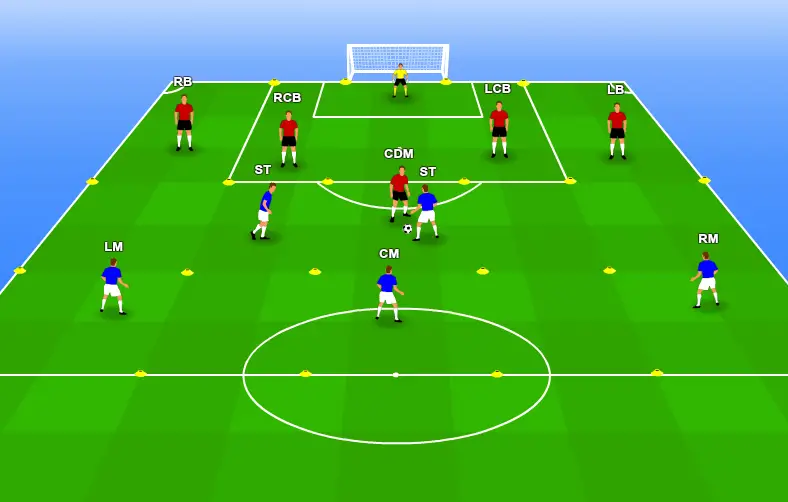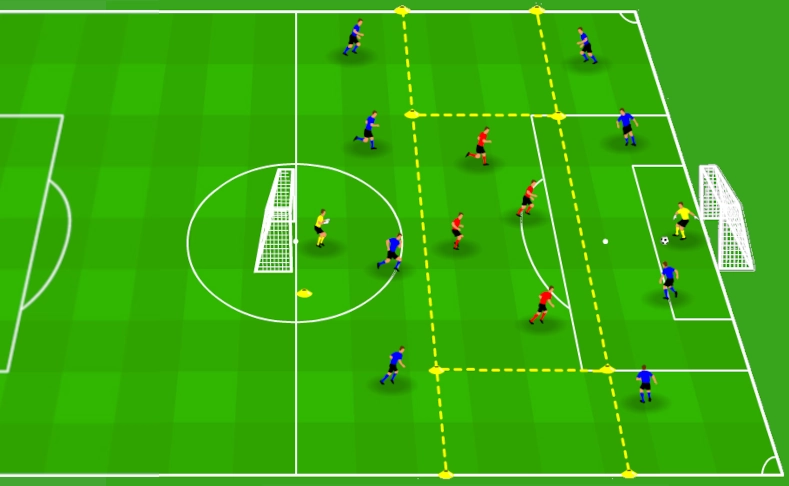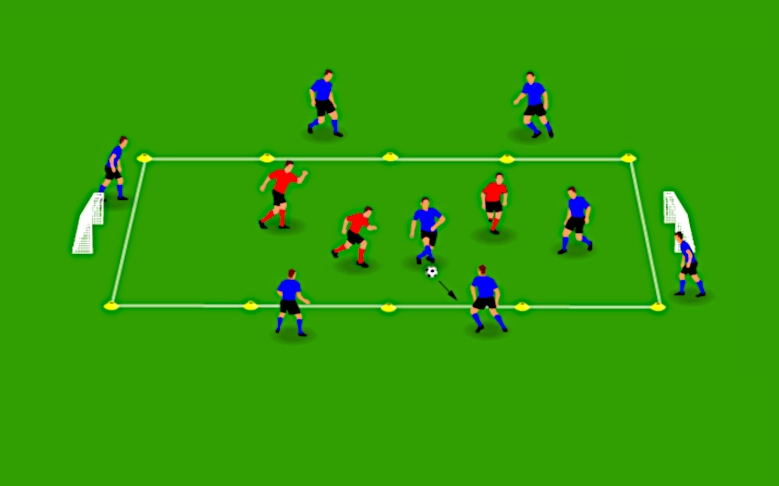Small-sided game to teach team shape

Team shape is the ability of players to maintain the team’s formation during a game, especially on defence. Maintaining team shape is actually harder than it sounds. In this post, we describe a simple exercise to help your players position in the field and maintain team shape.
Setup
This drill simulates real game scenarios. Therefore, practice it in a real football pitch with a full 11 aside team if possible. You only need half of the field. If your squad is over 20 players strong, you can have your substitutes practising the same drill in the other half of the pitch.
The setup is simple, using cones, create a grid in one half of the pitch. Mark 3 to 4 rows, but not more. The number of columns depends on your preferred formation. The team uses a 4-4-2 formation in the picture, with a defensive midfielder and a creative midfielder. This means that a minimum of 4 columns is required. In our example, a 5×3 grid is demarcated.
Rules
The drill aims to help players maintain shape as much as possible by limiting players movement. The exercise also encourages simple passes. To achieve this, players must provide support from a short distance. The basic rules of the game are:
- 2 teams (defensive players vs attacking players).
- 1 goalkeeper.
- The game starts from the middle of the park with players standing in their main formation (e.g., 4 defenders in line).
- When a player is in possession of the ball, only 1 opposition player can step into the same cell. This means a maximum of 2 players, one per team, can share a cell.
- Only 3 touches are allowed (e.g., 1 touch to control the ball, 1 touch to change direction and 1 touch to pass the ball).
- Passing is only allowed to a contiguous cell.
- Long crosses are not allowed.
- Attacking players can shoot from anywhere.
- If the attacking team breaks any of the previous rules, the drill restarts from the middle of the field.
- Two defensive players can’t step in the same cell to recover the ball from an attacking player. A free kick for the attacking team is awarded when they do this.
- If the defensive team intercepts the ball, their objective is to cross the midfield in a counterattack.
Be creative and add your own rules. For example, you may want to allow long crosses in attack but only from the last row. You may also want to play with unlimited touches. Whatever changes you make to this drill, keep in mind the objective: maintaining shape and players supporting each other from a short distance.
Lessons to be learned
The main idea of this game is for players to get used to the preferred team formation by using a grid system. However, there are many other lessons to highlight:
- Passing. Since limited touches are allowed, players need to circulate the ball around and, in the process, improve their passing technique.
- Players positioning. This drill is designed to allow you to practice your preferred formation. Players get used to their positions in the field by using the grid as guidance.
- Playing as a team. Although individual skills play a part in the game, limiting the time players can hold the ball forces everyone to play as a team.
- Keeping a compact shape. The ball can be passed only to a contiguous cell. Therefore forcing players to get closer in order to support their teammate in possession of the ball.
- Avoiding overlapping players or too many players in a section of the field. Limiting the number of players in a cell avoids situations in defence or attack in which too many players are in a section of the field. Therefore, forcing both teams to keep their shape.
- Transitioning from defence to attack. The defensive team’s objective is to recover the ball and reach the midfield in an orderly fashion. Therefore is not enough to intercept the ball and kick it high and out. The defensive team must keep the ball on the ground and circulate it with short passes.
- Finishing. This drill is played with a goalkeeper. Therefore your offensive players are faced with real finishing scenarios., including free kicks.
I hope you find this drill helpful. If you like this post, please share it with your friends. Also, if you know about other exercises or have questions, comment on our Facebook page.



